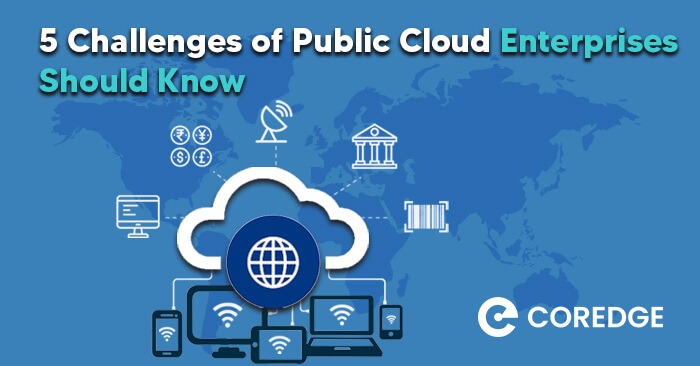5 Public Cloud Challenges Enterprises Face
Coredge Marketing
October 31, 2022

Cloud technology is now widely used by both large and small businesses. According to the latest survey, 69% of enterprises have accelerated their cloud migration over the past 12 months.
However, new advancements often bring about new challenges. Controlling the cost, data privacy and security, protecting cloud resources, governance, compliance, and lack of experience are some of the biggest public cloud challenges that enterprises face when using the public cloud. Let us discuss them in detail.
Business continuity is a top responsibility for any company worldwide in these unsettling times. Initiatives for enterprise digital transformation have seamlessly incorporated the need for resilience along with flexibility. Eight out of ten businesses said in recent research that the cloud is more crucial now than it was last year. The public cloud is extremely popular with businesses, but why?
The public cloud is reasonably priced. Virtually no fixed costs” & “a pay-as-you-go consumption-based pricing. It is simple to scale up or down and to customize. More importantly, it offers 99% uptime with virtually little failure risk.
Multiple servers are connected through the system. Therefore, the other servers handle the workload automatically even if a single server fails. By doing this, it guarantees that there won’t be any unforeseen interruption to operations.
Although there are many benefits to using the public cloud, it is plagued with major challenges. The good news is that now you can overcome these difficulties, as we shall explore in our blog, provided your company has the tools and procedures in place to stay up with the industry’s ongoing advances in the public cloud.
Top 5 Challenges of Public Cloud Enterprises:
- Lack of required skills and information: Lack of knowledge was highlighted by many organizations as their biggest challenge to cloud migration. An established application must be migrated with care to the public cloud. Without a sound migration strategy or the incorrect cloud service model selection, the migration may not succeed.Critical applications, like the ERP suite, can be migrated to the cloud, but doing so raises questions about whether they will function as well there as they did on-premises. Another issue for businesses related to public cloud migration is application sizing.
Because public cloud infrastructure is shared by other businesses, those businesses must decide if the scale of legacy applications that ran smoothly in a dedicated environment will pose a challenge in a shared environment. Due to a lack of expertise and awareness regarding the barriers they face during migration, businesses frequently get stuck at this stage.
- Failing to keep up with new developments and updates: To support businesses in innovating and expanding, public cloud providers release new upgrades, features, and tools. These updates support business innovation and provide them with a competitive edge.However, when it happens quickly, it also poses a challenge for them. Businesses are unable to track the changes and make the necessary adjustments. Sometimes, the cloud infrastructure evolves more quickly than the applications that use it. Plans for usage and accessibility are affected by all of these variables.
- Governance and compliance: Enterprises are very concerned about governance and compliance. This has been cited by several enterprises as one of the main reasons for reluctance towards adopting public clouds.Common governance issues include a lack of responsibility, the inability of important parties to agree on best practices for cloud compliance, the absence of a defined disaster recovery mechanism, and a lack of training.
Cloud compliance becomes challenging, particularly in industries with strong standards like healthcare where businesses must adhere to rules like HIPAA. Companies need to ensure that their cloud approach complies with established policies and is consistent with their overarching business plans.
To protect their company’s security, they must carefully walk the line between using the public cloud for data backup and archiving and abiding by industry laws.
- Security and privacy: Cloud security is frequently the top priority for organizations when allocating IT budgets. Enterprises must safeguard data and applications in the cloud against unauthorized and unauthenticated users, identity theft, data breaches, and a lack of a solid security architecture.Since the pandemic, the majority of employees now work from home, and security and privacy have elevated in importance. Enterprises must secure their cloud-based applications in addition to the cloud services that cloud providers protect. They must make sure that they adhere to security standards and that their security team collaborates with the cloud service providers to develop a thorough and effective data protection policy.
The company could suffer consequences due to a lack of security knowledge and the absence of tools and procedures.
- Data Ownership: Data ownership should be taken into consideration as a risk. Your cloud provider controls your data if you’re using a public cloud. Ensure that your organization owns the rights to your data by carefully reviewing your SLA.Many of the largest cloud service providers in the world have legal provisions claiming ownership of consumer data. Not only does it act as legal protection, but many providers earn a large amount by selling the data. Making an impenetrable SLA with your supplier is one strategy to protect against data loss for organizations that commit to their clients to ensure that their data is kept secret.
You might also think about using the public cloud to store only non-confidential data or just choose a service provider that allows you to retain ownership.
Move to Private Cloud to Overcome Public Cloud Challenges
The market for cloud computing is continually changing to meet the needs of businesses. Businesses need to select the best public cloud service provider, plan their finances, create use cases, migrate to the cloud, train their teams, and perform many other activities. It can be difficult to plan and migrate to the cloud. Enterprises require the assistance of specialists who can aid them in their cloud transformation. Coredge provides end-to-end cloud assistance so that your businesses can operate smoothly. Our team of professionals helps companies with their expertise. Connect with us to know more about our Cirrus Cloud Platform and services and also let us know your requirements so that we can assist you better.





